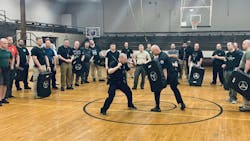Training to Use Less Force: A Trainer's Use of Force Management Tips
With staffing shortages and budget shortfalls affecting law enforcement agencies throughout the country, finding ample time to train on use of force management and less-lethal tactics can be difficult. Coupled with the laser-sharp focus on the actions of officers on the street by both the public and the media, the training officers do receive becomes even more crucial.
This article appeared in the July/August issue of OFFICER Magazine. Click Here to subscribe to OFFICER Magazine.
Retired NYPD Officer James Schramm, who served in the agency’s Tactical Training Unit for 10 years, has been a trainer with Armament Systems and Procedures, Inc. (ASP) since 2004. Schramm recently shared his insights on use of force management and less-lethal training with OFFICER Magazine.
How has use of force management training changed over the course of the last decade?
The advances in technology and improvement in equipment design have significantly improved the officer’s ability to control subjects with less-lethal force options. Comparing the TASER from when I was still active (2011) to now, there is a greater range, accuracy, and the ability to control multiple subjects by one officer.
How have the use of less-lethal tools and devices changed?
Because of the changes and advancements in tools and devices, officers are more likely to utilize less-lethal force options in confrontations. Impact weapons are more compact, lighter, and easier to deploy and re-case than they were 10 years ago. These new designs greatly increase the probability of officers carrying impact weapons.
What have you seen law enforcement officers struggle with the most during training?
Complex moves or techniques that require precision or multiple steps usually fail under stress. When introducing these techniques in slow-controlled drills, officers are able to perform them, however, add speed and stress of a realistic scenario, and you will find that these same officers are unable to successfully perform the techniques. One of the principles we use in our training is “Forgiving Techniques.” Forgiving Techniques are procedures and principles that remain effective even if not done exactly right.
What should law enforcement agencies focus on more when it comes to less-lethal training?
More time should be devoted to less-lethal and use-of-force training. I know this is not always feasible with staffing shortages and hiring freezes, but just once or twice a year is not nearly enough time for officers to maintain a level of proficiency in their defensive tactics. Keep training simple, complexity in moves and techniques will not be retained by the average officer. Encourage officers to train on their own, outside of work. Law enforcement officers are professionals who depend on their training and their proficiency in the equipment they carry to maintain the safety of the public and themselves. Professional athletes train year round to perfect their skills. We need to do the same. The difference is our life may depend on it.
About the Author
Paul Peluso
Editor
Paul Peluso is the Managing Editor of OFFICER Magazine and has been with the Officer Media Group since 2006. He began as an Associate Editor, writing and editing content for Officer.com. Previously, Paul worked as a reporter for several newspapers in the suburbs of Baltimore, MD.


